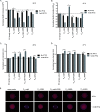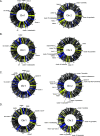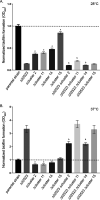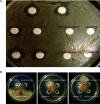Disruption of c-di-GMP Signaling Networks Unlocks Cryptic Expression of Secondary Metabolites during Biofilm Growth in Burkholderia pseudomallei
- PMID: 35357191
- PMCID: PMC9040570
- DOI: 10.1128/aem.02431-21
Disruption of c-di-GMP Signaling Networks Unlocks Cryptic Expression of Secondary Metabolites during Biofilm Growth in Burkholderia pseudomallei
Abstract
The regulation and production of secondary metabolites during biofilm growth of Burkholderia spp. is not well understood. To learn more about the crucial role and regulatory control of cryptic molecules produced during biofilm growth, we disrupted c-di-GMP signaling in Burkholderia pseudomallei, a soilborne bacterial saprophyte and the etiologic agent of melioidosis. Our approach to these studies combined transcriptional profiling with genetic deletions that targeted key c-di-GMP regulatory components to characterize responses to changes in temperature. Mutational analyses and conditional expression studies of c-di-GMP genes demonstrates their contribution to phenotypes such as biofilm formation, colony morphology, motility, and expression of secondary metabolite biosynthesis when grown as a biofilm at different temperatures. RNA-seq analysis was performed at various temperatures in a ΔII2523 mutant background that is responsive to temperature alterations resulting in hypobiofilm- and hyperbiofilm-forming phenotypes. Differential regulation of genes was observed for polysaccharide biosynthesis, secretion systems, and nonribosomal peptide and polyketide synthase (NRPS/PKS) clusters in response to temperature changes. Deletion mutations of biosynthetic gene clusters (BGCs) 2, 11, 14 (syrbactin), and 15 (malleipeptin) in parental and ΔII2523 backgrounds also reveal the contribution of these BGCs to biofilm formation and colony morphology in addition to inhibition of Bacillus subtilis and Rhizoctonia solani. Our findings suggest that II2523 impacts the regulation of genes that contribute to biofilm formation and competition. Characterization of cryptic BGCs under different environmental conditions will allow for a better understanding of the role of secondary metabolites in the context of biofilm formation and microbe-microbe interactions. IMPORTANCE Burkholderia pseudomallei is a saprophytic bacterium residing in the environment that switches to a pathogenic lifestyle during infection of a wide range of hosts. The environmental cues that serve as the stimulus to trigger this change are largely unknown. However, it is well established that the cellular level of c-di-GMP, a secondary signal messenger, controls the switch from growth as planktonic cells to growth as a biofilm. Disrupting the signaling mediated by c-di-GMP allows for a better understanding of the regulation and the contribution of the surface associated and secreted molecules that contribute to the various lifestyles of this organism. The genome of B. pseudomallei also encodes cryptic biosynthetic gene clusters predicted to encode small molecules that potentially contribute to growth as a biofilm, adaptation, and interactions with other organisms. A better understanding of the regulation of these molecules is crucial to understanding how this versatile pathogen alters its lifestyle.
Keywords: Burkholderia pseudomallei; biofilm; c-di-GMP; diguanylate cyclase; malleipeptin; syrbactin.
Conflict of interest statement
The authors declare no conflict of interest.
Figures











Similar articles
-
Biofilm Signaling, Composition and Regulation in Burkholderia pseudomallei.J Microbiol Biotechnol. 2023 Jan 28;33(1):15-27. doi: 10.4014/jmb.2207.07032. Epub 2022 Oct 17. J Microbiol Biotechnol. 2023. PMID: 36451302 Free PMC article. Review.
-
Thermoregulation of Biofilm Formation in Burkholderia pseudomallei Is Disrupted by Mutation of a Putative Diguanylate Cyclase.J Bacteriol. 2017 Feb 14;199(5):e00780-16. doi: 10.1128/JB.00780-16. Print 2017 Mar 1. J Bacteriol. 2017. PMID: 27956524 Free PMC article.
-
The NarX-NarL two-component system regulates biofilm formation, natural product biosynthesis, and host-associated survival in Burkholderia pseudomallei.Sci Rep. 2022 Jan 7;12(1):203. doi: 10.1038/s41598-021-04053-6. Sci Rep. 2022. PMID: 34997073 Free PMC article.
-
Nitrate Sensing and Metabolism Inhibit Biofilm Formation in the Opportunistic Pathogen Burkholderia pseudomallei by Reducing the Intracellular Concentration of c-di-GMP.Front Microbiol. 2017 Jul 25;8:1353. doi: 10.3389/fmicb.2017.01353. eCollection 2017. Front Microbiol. 2017. PMID: 28790983 Free PMC article.
-
Controlling Biofilm Development Through Cyclic di-GMP Signaling.Adv Exp Med Biol. 2022;1386:69-94. doi: 10.1007/978-3-031-08491-1_3. Adv Exp Med Biol. 2022. PMID: 36258069 Free PMC article. Review.
Cited by
-
Genetic Dissection of Cyclic di-GMP Signalling in Pseudomonas aeruginosa via Systematic Diguanylate Cyclase Disruption.Microb Biotechnol. 2025 Apr;18(4):e70137. doi: 10.1111/1751-7915.70137. Microb Biotechnol. 2025. PMID: 40172309 Free PMC article.
-
Biofilm Signaling, Composition and Regulation in Burkholderia pseudomallei.J Microbiol Biotechnol. 2023 Jan 28;33(1):15-27. doi: 10.4014/jmb.2207.07032. Epub 2022 Oct 17. J Microbiol Biotechnol. 2023. PMID: 36451302 Free PMC article. Review.
References
-
- Bulterys PL, Bulterys MA, Phommasone K, Luangraj M, Mayxay M, Kloprogge S, Miliya T, Vongsouvath M, Newton PN, Phetsouvanh R, French CT, Miller JF, Turner P, Dance DAB. 2018. Climatic drivers of melioidosis in Laos and Cambodia: a 16-year case series analysis. Lancet Planet Health 2:e334–e343. 10.1016/S2542-5196(18)30172-4. - DOI - PMC - PubMed
Publication types
MeSH terms
Substances
Grants and funding
LinkOut - more resources
Full Text Sources
Miscellaneous

